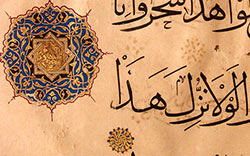- Separators
- Shamsah
Shamsah
A circular decoration that is usually drawn on the beginning pages of a manuscript. Usually the name of the title of the book, the patron or the person to whom the manuscript is gifted is written in it. Here, however, it is used to section the Qur'an into smaller parts in order to facilitate its memorization and recitation.
- Decorative and Functional Notations
Decorative and Functional Notations
There are three types of notations written here with a thinner pen. Those marked by white arrows are strictly decorative and serve no orthographic function. Interestingly, some of them are the same as the letter under which they are written, but in a different form. In contrast to the notations marked with white arrows, those marked with red arrows are functional. They help with the pronunciation of the qur'anic text, particularly by non-Arabic speakers. They show when the sound of a letter should be elongated and when a letter should be elided to connect two words. The remaining notations in thin lettering are short vowels that are usually not found in written Arabic, except in qur'anic texts written after the first centuries of Islam.
- Sharafah
Sharafah
Thin lines that, like the rays of the sun, are drawn from the shamseh or sarluh outward.
- Select a language
- English
- فارسی



